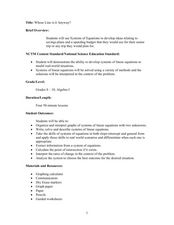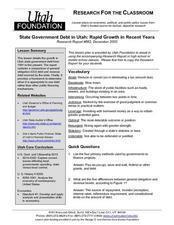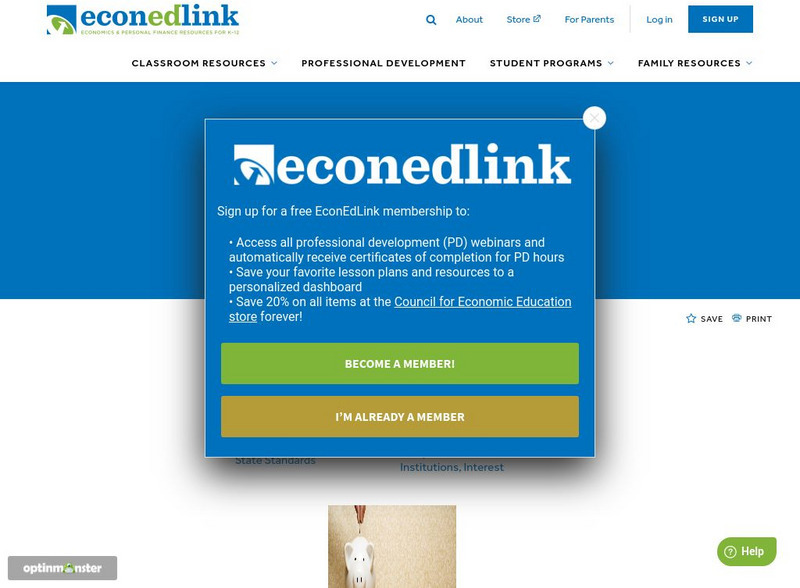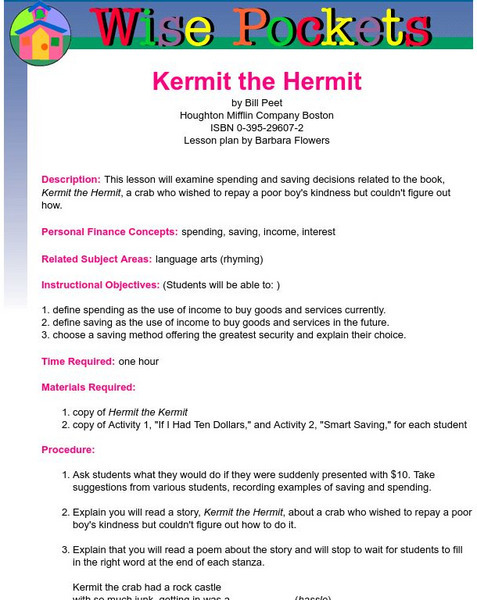Curated OER
Smithsonian Research Cuts
Learners investigate the Smithsonian research projects of 2001. They complete a Webquest that explores the Smithsonian Institution website, answer discussion questions, and locate newspaper articles about research conducted by the forest...
Curated OER
Hey, Mom! What's for Breakfast?
Students examine how he world eats breakfast. In this food choices lesson, students work in groups to list breakfast foods and their ingredients and find goods and consumers on the list. The, students use the Internet to complete a...
Curated OER
Whose Line is it Anyway?
Students solve systems of equations. In this algebra lesson, students identify the domain and range of each function. They use the slope and y-intercept to graph each line.
Curated OER
Credit: Buy Now & Pay More Later
Young scholars analyze the costs and benefits of using credit cards to purchase goods and services.
Curated OER
State Government Debt in Utah: Rapid Growth in Recent Years
Students examine growth of debt in Utah state government from 1991 to present, compare general obligation debt and revenue debt incurred by state, identify four primary methods used by governments to finance projects, and complete...
Council for Economic Education
Econ Ed Link: A Penny Saved Is a Penny at 4.7% Earned
This is a lesson from EconEdLink where students learn about saving money. Includes activities and materials.
Consumer Financial Protection Bureau
Consumer Financial Protection Bureau: Saving Each Payday
Students use a real-world simulation to learn how saving a little money each payday can be a successful strategy for saving. Includes teaching guide and student worksheet that can be filled in on a computer.
Yale University
Yale New Haven Teachers Institute: Income Budgeting
This site contains a unit on budgeting money for use by middle school teachers. Includes enrichment problems, a bibliography, and many example problems and situations.
Yale University
Yale New Haven Teachers Institute: Income Budgeting
This site contains a unit on budgeting money for use by middle school teachers. Includes enrichment problems, a bibliography, and many example problems and situations.
Practical Money Skills
Practical Money Skills: Lessons: College
Ten financial literacy lesson plans allow college students to build on their skills and cover topics such as budgeting, living on your own, managing credit cards, cars and loans, and saving and investing.
Practical Money Skills
Visa: Practical Money Skills: Lesson Plans for Grades 7 8
Fourteen financial literacy lesson plans for middle school students cover topics such as budgeting, living on your own, the influence of advertising, and saving and investing.
Practical Money Skills
Practical Money Skills: Lessons: Special Needs
Ten customizable financial lessons designed for special needs students.
Council for Economic Education
Econ Ed Link: Money Comes and Goes
Young scholars read two online stories that introduce them to the elements of a budget and show that a successful budget balances money coming in (income) with money going out (expenses and savings). Follow-up activities point out the...
Scholastic
Scholastic: Adventures in Math: Lesson 4: How to Use Your Money
In this activity, young scholars will identify why having a budget and keeping records of their spending and saving habits helps them make better financial choices.
Federal Reserve Bank
Federal Reserve Bank of St. Louis: Less Than Zero [Pdf]
This lesson accompanies a story by Stuart J. Murphy called Less Than Zero and teaches students about how to manage their money by saving it and setting goals for themselves.
Council for Economic Education
Econ Ed Link: Big Banks, Piggy Banks
Use this informative economics lesson plan. Find out how to save your money. "You will read about safe places for keeping money; you also will learn about places where money can earn money."
University of Missouri
University of Missouri St. Louis:wise Pockets: Kermit the Hermit
This is an elementary level lesson that deals with spending, saving, income, and interest. Requires the book Kermit the Hermit by Bill Peet. Includes detailed lesson plan along with procedures and activities.
Practical Money Skills
Practical Money Skills at Home: Allowance and Savings
Ideas to teach children the importance of saving and the value of an allowance using this activity. Suggestions for conveying these ideas include related worksheets to help children better grasp these concepts.
Alabama Learning Exchange
Alex: Wild Water Adventure
Students will learn how a system of equations can be used to find the best use of information to make decisions in real-world situations.Students will work in groups of 3s or 4s to develop a system for the best buy on tickets at a water...
Other
Money Management International: The Berenstain Bears' Trouble With Money
A lesson plan featuring the Berenstain Bears that introduces the concepts of spending, goods, services, income, saving, and interest.
Council for Economic Education
Econ Ed Link: Clickety Clack, Let's Keep Track!
This lesson will show students the importance of keeping track of their savings.
Federal Reserve Bank
Federal Reserve Bank of St. Louis: The Pickle Patch Bathtub [Pdf]
A lesson based on The Pickle Patch Bathtub by Frances Kennedy, where students learn about making choices in how to spend money, and how to set goals and develop a savings plan.
Council for Economic Education
Econ Ed Link: Every Penny Counts
Lesson that helps students understand that people must make choices about the goods and services they purchase. Students recognize the prices indicate what people pay for goods and services, learn to compare prices, and understand that...
Council for Economic Education
Econ Ed Link: Opportunity Cost
Consumers are faced with tough choices because so many innovative and exciting products and services are available. Therefore, engraining a decision-making process that includes considering of opportunity cost is necessary to shape...
















